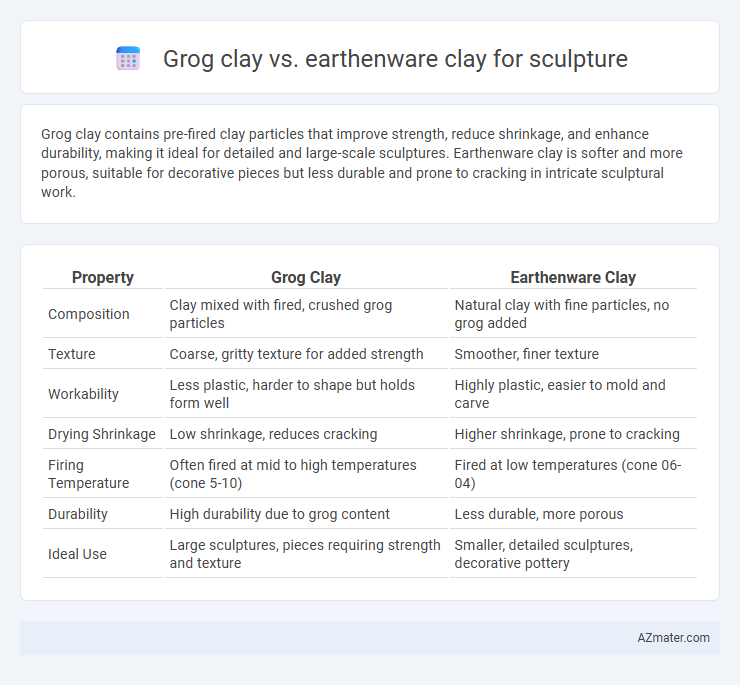Grog clay contains pre-fired clay particles that improve strength, reduce shrinkage, and enhance durability, making it ideal for detailed and large-scale sculptures. Earthenware clay is softer and more porous, suitable for decorative pieces but less durable and prone to cracking in intricate sculptural work.
Table of Comparison
| Property | Grog Clay | Earthenware Clay |
|---|---|---|
| Composition | Clay mixed with fired, crushed grog particles | Natural clay with fine particles, no grog added |
| Texture | Coarse, gritty texture for added strength | Smoother, finer texture |
| Workability | Less plastic, harder to shape but holds form well | Highly plastic, easier to mold and carve |
| Drying Shrinkage | Low shrinkage, reduces cracking | Higher shrinkage, prone to cracking |
| Firing Temperature | Often fired at mid to high temperatures (cone 5-10) | Fired at low temperatures (cone 06-04) |
| Durability | High durability due to grog content | Less durable, more porous |
| Ideal Use | Large sculptures, pieces requiring strength and texture | Smaller, detailed sculptures, decorative pottery |
Introduction to Grog Clay and Earthenware Clay
Grog clay contains pre-fired, ground ceramic particles mixed into the clay body, enhancing strength, reducing shrinkage, and improving thermal resistance, making it ideal for sculptures requiring durability and texture. Earthenware clay is a porous, low-fired clay that matures at lower temperatures, offering vibrant natural colors but less structural stability compared to grog clay. Sculptors choose grog clay for robust, detailed forms, while earthenware is favored for its warm hues and ease of shaping in decorative pieces.
Key Characteristics of Grog Clay
Grog clay contains pre-fired clay particles that enhance its strength, reduce shrinkage, and improve thermal shock resistance, making it ideal for sculpting intricate designs and large forms. The added grog improves workability by providing texture and prevents cracking during drying and firing processes compared to standard earthenware clay. This characteristic makes grog clay especially suitable for durable, detailed sculptures prone to stress during handling and firing cycles.
Key Characteristics of Earthenware Clay
Earthenware clay is characterized by its porous nature and low firing temperature, typically between 1,000degC and 1,150degC, which makes it more prone to water absorption compared to grog clay. It has a smooth texture but can be less durable than grog clay due to the absence of grog particles that enhance structural strength and reduce shrinkage. The rich iron content in earthenware clay often results in warm, reddish tones after firing, making it ideal for decorative sculptures but less suited for high-stress functional pieces.
Workability for Sculptors: Grog vs Earthenware
Grog clay contains pre-fired clay particles that improve workability by reducing shrinkage and increasing strength, making it ideal for sculptors seeking durability and texture during modeling. Earthenware clay, while softer and more malleable, tends to shrink and crack more easily, requiring careful handling and slower drying times. Sculptors often choose grog clay for complex, large-scale works due to its enhanced stability, whereas earthenware is preferred for finer detail and delicate forms.
Texture and Surface Finish Comparison
Grog clay contains pre-fired clay particles that enhance texture by providing a gritty, coarse surface ideal for sculptures requiring durability and reduced shrinkage. Earthenware clay, by contrast, has a smoother texture that allows for finer detail but may be more fragile and prone to warping during firing. Sculptors often select grog clay for robust, textured finishes, while earthenware is preferred for delicate surface detail and vibrant glaze application.
Strength and Durability in Sculpture
Grog clay contains pre-fired clay particles that enhance its strength and reduce shrinkage, making it ideal for sculptors requiring durable, crack-resistant pieces. Earthenware clay is more porous and less durable, often needing sealing and careful handling to prevent breakage and wear over time. Sculptures crafted with grog clay exhibit higher resistance to physical stress and thermal shock compared to those made from traditional earthenware.
Firing Temperature Differences
Grog clay contains pre-fired clay particles that enhance thermal shock resistance, allowing it to withstand higher firing temperatures of around 1200degC to 1300degC, compared to earthenware clay which typically matures at lower temperatures between 1000degC and 1150degC. The inclusion of grog in the clay body reduces shrinkage and improves structural integrity during firing, making it ideal for larger or more intricate sculptures that require durability. Earthenware clay, being more porous and fired at lower temperatures, is suitable for decorative pieces but less robust for high-temperature applications.
Suitability for Fine Detailing
Grog clay contains ground fired clay particles that improve shrinkage control and enhance structural integrity, making it suitable for larger, more robust sculptures but less ideal for fine detailing due to its coarser texture. Earthenware clay, with its finer particle size and smooth consistency, excels in capturing intricate details and delicate features, making it the preferred choice for detailed sculptural work. The higher plasticity and softer nature of earthenware allow artists to achieve crisp, precise lines that grog clay typically cannot reproduce as effectively.
Common Applications in Sculpture
Grog clay, infused with ground fired clay particles, offers enhanced strength and reduced shrinkage, making it ideal for large, durable sculptures and functional pottery requiring high structural integrity. Earthenware clay, characterized by its porous nature and lower firing temperature, is commonly used for decorative sculptures, detailed relief work, and projects emphasizing surface texture and color variations. Sculptors often choose grog clay for robust outdoor installations and earthenware clay for indoor artistic pieces with intricate detailing.
Choosing the Right Clay for Your Sculpture Project
Grog clay offers enhanced durability and reduced shrinkage, making it ideal for large or intricate sculptures requiring structural strength and heat resistance. Earthenware clay, known for its smooth texture and ease of shaping, suits beginners and projects emphasizing fine detail rather than extreme durability. Select grog clay for functional, robust pieces and earthenware for delicate, decorative sculptures to optimize your artistic outcomes.

Infographic: Grog clay vs Earthenware clay for Sculpture
 azmater.com
azmater.com